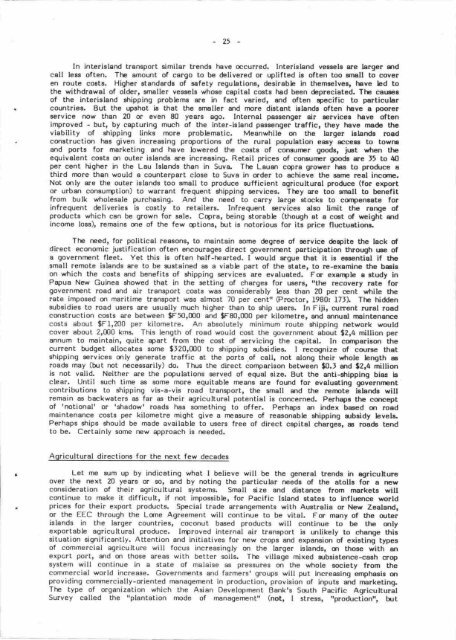Rt€@lll
Rt€@lll
Rt€@lll
You also want an ePaper? Increase the reach of your titles
YUMPU automatically turns print PDFs into web optimized ePapers that Google loves.
'25<br />
In interisland transport similar trends have ceurred. Interislend vessels ere larger md<br />
cell lees often. Tlp amount of cargo to be delivered or uplifted is often too srnall to cover<br />
en route cogts. Higher atandards of safety regulations, desirabb in themaelvea, have led to<br />
the withdrawal of older, srnaller vessels whoae capital cogts hsd been deprecieted. Tle carrea<br />
of the interisland ehipping problems are in fact varied, and often pecific to perticubr<br />
countries. But the upshot is that the smaller and rmre distant islands often have a poorer<br />
service now than 20 or even 80 yesrs ego. Internal passenger air servicer have often<br />
improved - but, by capturing much of t}e inter-island pa$enger traffic, they have made the<br />
viability of sttipping links more problematic. Meenwhile on the larger islsrds road<br />
construction has given increasing proportions of the rural population eesy rcess to towns<br />
and ports for marketing and heve lowered the costs of conEuner gooda, jr.st wtren the<br />
equivalenl coets m outer islands are increesing. Retail pricee of consurEr goods are f5 to 4{l<br />
per cent Ngher in the Lau lclandg than in Suva. The Lauan copra grower hes to produce a<br />
lhird nnre than would a counterpart close to Suva in order to mhieve the sarne real incqne.<br />
Not mly ere the outer islands too srnall to produce srfficient agricultural produce (for export<br />
or urban consunption) to warrant frequent stripping services. Tlcy are too smell to benefit<br />
from bulk wholesele purchasing. And the need to carry large stocks to csrpenrate for<br />
infrequent deliveriea is costly to retailers. lnfrequent servicee also limit the range of<br />
products which can be grown for sale. Copra, being storabb (though st I cct of weight md<br />
incorne loss), remains trre of the few qtiona, but is notorious fon ite price fluctuations.<br />
The need, for political reasons, to maintein some degree of -rvice &spite the lack of<br />
direct economic justification often encourages direct governnEnt participation through use of<br />
a governrnnt fleel. Yet this is often helf-hearted. I would mgue thet it is essential if the<br />
small remote islends are to be sustained as a viabb part of the state, to re-examine the bsig<br />
on which the costs and benefits of sfripping services are evaluated. Foc exarple a study in<br />
Papua New Guinea showed that in the setting of charges for uaero, "the recovery rate for<br />
governrnent road and air lransport costs was considerably bss than 20 per cent wtrile tlre<br />
rate imposed m maritime transport was almost 70 per cent" (Prpctor, 1980: l7)). The hidden<br />
subsidies to road users are r.sually much higher than to strip users. In Fiji, current rural road<br />
cmstruction costs are between fF50r(trO and fF80r000 per kilometre, and mnual nraintenanc-e<br />
costs about fFl'200 per kilometre. An absolutely minimum route stripping rntwork would<br />
cover about 2rfi)0 kms. This length of road would cost the governnent about f2r4 million per<br />
annum to maintainr quite apart from the cost of servicing the capital. In cmrparison the<br />
current budget allocates some f)20rffi0 to stripping subsi-dies. I recognize of courae that<br />
shipping services mly generale traffic at the ports .of call, not along their ufiole bngth s<br />
roads may (but not necessarily) do. Thus the direct comparison between S0.l gtO i2r4 million<br />
is not valid. Neither are the populations served of equal size. But the anti-stripping bias b<br />
clear. Until such time as rnme rrnre equitable means are found for eveluating governnnnt<br />
contributions to shipping vis-a-vis road transport, the small and the renpte ielands wiil<br />
remain as backwaters as far as Lheir agricultural potential is concerned. Perhape the concept<br />
of Inotional' or rstradow' roads has something to offer. Perhaps an index based m road<br />
maintenance cosLs per kilometre might give a measure of reesonable shipping rrbsidy bvele.<br />
Perhaps sttips should be made available to users free of direct capital charges, s roads tend<br />
to be. Certainly some new approach is needed.<br />
Aqricultural directions for the next few decades<br />
Let me sum up by indicating what I believe will be the general trends in agricuhure<br />
over the next 20 years or so, and by noting the particular needs of the atolls for a new<br />
consideration of their agricultural systems. Small size and distance from markets will<br />
continue to make it difficult, if not impossibb, for Pacific Island stetes to influence world<br />
prices for their export produets. Special trade arrangements with Australia or New Zealand,<br />
or lhe EEC through the Lane Agreement will continue to be vital. For many of the outer<br />
islands in the larger countries, coconut based products will continue to be the rtly<br />
exportable agricultural produce. Inproved internal air transport is unlikely to c*range this<br />
situetion significantly. Attention and initiatives for new crops and expansion of existing types<br />
of commercial agriculture will focus increasingly on the larger islands, sr those with an<br />
export port' and m those areas with better soils. The village mixed subsistence-cash crop<br />
system will continue in a state of malaise €rs pressures on the whole society from the<br />
commercial world increase. Governments and farmersr qroups will put increasing emphasis an<br />
providing commercially-oriented menagement in production, provision of inputs and rnarketing.<br />
The type of organization which lhe Asian Development Bank's Sor.lth Pacific Agnicultural<br />
Survey called the "plantation rmde of managementtt (not, I streas, 'rproductionrr, but














![R]€@lll](https://img.yumpu.com/7594335/1/175x260/reurlll.jpg?quality=85)
